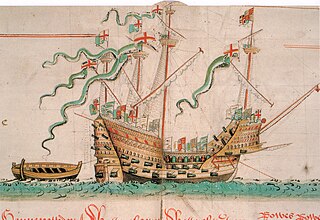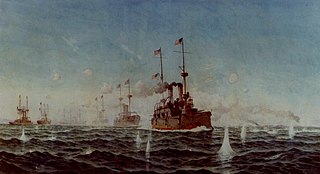Don de Dieu (French for 'the gift of God') primarily refers to the ship in which Samuel de Champlain reached present-day Quebec in 1608.
Don de Dieu may also refer to:

The Mary Rose was a carrack in the English Tudor navy of King Henry VIII. She was launched in 1511 and served for 33 years in several wars against France, Scotland, and Brittany. After being substantially rebuilt in 1536, she saw her last action on 19 July 1545. She led the attack on the galleys of a French invasion fleet, but sank in the Solent, the strait north of the Isle of Wight.

The Battle of Manila Bay, also known as the Battle of Cavite, took place on 1 May 1898, during the Spanish–American War. The American Asiatic Squadron under Commodore George Dewey engaged and destroyed the Spanish Pacific Squadron under Contraalmirante Patricio Montojo. The battle took place in Manila Bay in the Philippines, and was the first major engagement of the Spanish–American War. The battle was one of the most decisive naval battles in history and marked the end of the Spanish colonial period in Philippine history.
Anjou may refer to:

In French-speaking countries, a hôtel-Dieu was originally a hospital for the poor and needy, run by the Catholic Church. Nowadays these buildings or institutions have either kept their function as a hospital, the one in Paris being the oldest and most renowned, or have been converted into hotels, museums, or general purpose buildings.
Nancy may refer to:
A droit is a legal title, claim or due.
Grace Dieu can refer to:

Grace Dieu was the flagship of King Henry V of England and one of the largest ships of her time. Launched in 1418, she sailed on only one voyage and was subsequently laid up at anchor in the River Hamble. She burned in 1439 after being struck by lightning. The wreck is a Protected Wreck managed by Historic England.

The coat of arms of Quebec City

The flag of Quebec City was officially adopted on January 12, 1987.

Explorer Samuel de Champlain arrived on the ship Don de Dieu, or "Gift of God" to found Quebec in 1608.

Rayo was an 80-gun ship of the line of the Spanish Navy. As was traditional for Spanish ships not named after a saint, its second, dedicatory name was San Pedro Apóstol. She underwent rebuilding at Cartagena from 1803 to 1805, emerging as a three-decked ship with 100 guns. She then fought at the Battle of Trafalgar during the Napoleonic Wars and was dismasted as a result of damage sustained in the battle. When she sortied after Trafalgar in order to recover prizes, the warship was captured by HMS Donegal. Subsequently, she ran aground and was wrecked in a storm. Her broken hull was set ablaze and destroyed by British sailors on 31 October.

The Battle of Hanoi on 25 April 1882, was the illegal capture by French naval captain Henri Rivière, acting without his superiors' orders. The French handed the city back later.
Five steamships have borne the name Tottenham, after Tottenham in the United Kingdom:

Three vessels bearing the name Regent or HMS Regent have served England or the Royal Navy:
Holigost was a carrack of the English navy rebuilt for Henry V. Originally a Castillian vessel called Santa Clara, she was captured c. 1413–14. She served until 1422 and later sank at her moorings. Her wreck is believed to have been found in the River Hamble, Hampshire, near the wreck of her larger contemporary, the Grace Dieu. The wreck is a Protected Wreck managed by Historic England.
Sévère was a 64-gun ship of the line of the French Navy.